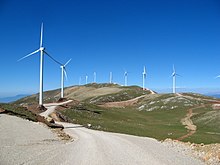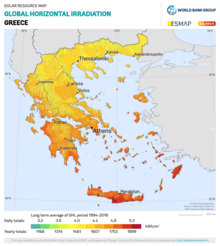Renewable energy in Greece
Renewable energy in Greece accounted for 8% of the country's total energy consumption in 2008.[1] 12% of Greece's electricity comes from hydroelectric power plants.[2]
In August 2016, a new renewable energy law was approved that aims to further stimulate renewable energy investments by introducing feed-in premiums, competitive tenders, and virtual net metering.[3] Under the new law, the compensation for renewable energy producers will consist of what they receive in the electricity market plus a variable feed-in premium. The latter is the difference between a price depending on market variables (e.g., the system’s marginal price) and a set price decided via a competitive tender.[3] Furthermore, from the beginning of 2017, the new scheme to approve new renewable energy capacity is based on competitive tenders, where the Energy Minister is able to call on a tender for specific capacities and technologies.[3]
Wind power[]

Wind power was due to expand[when?] by 352% by 2010 to meet the European target of 20% coverage of energy needs from renewable sources. Previously,[when?] there were 1,028 wind turbines installed throughout Greece and the number was set to reach 2,587 wind turbines before the end of 2010.[4]
According to the Ministry of Environment and Public Works, the system would have a nameplate capacity of 3,372 MW of power from wind alone[when?] compared to 746 MW at the end of 2006.[5] Greece chose to invest primarily to wind power by 77%, while the rest of renewable sources altogether comprise the remaining 23% of production with hydroelectric power being second with 11%.[6][7]
The Centre for Renewable Energy Sources and Saving (CRES) is the Greek national entity for the promotion of renewable energy sources, rational use of energy and energy conservation.[8]
Timeline[]

| year | MW | change | change % |
|---|---|---|---|
| 1987 | 0.8 | 0.0 | 0.0% |
| 1988 | 0.8 | 0.0 | 0.0% |
| 1989 | 1.1 | 0.3 | 27.3% |
| 1990 | 1.5 | 0.4 | 26.7% |
| 1991 | 3.9 | 2.4 | 61.5% |
| 1992 | 19.4 | 15.5 | 79.9% |
| 1993 | 26.0 | 6.6 | 25.4% |
| 1994 | 26.6 | 0.6 | 2.3% |
| 1995 | 27.3 | 0.7 | 2.6% |
| 1996 | 27.3 | 0.0 | 0.0% |
| 1997 | 27.3 | 0.0 | 0.0% |
| 1998 | 38.8 | 11.5 | 29.6% |
| 1999 | 107.0 | 68.2 | 63.7% |
| 2000 | 237.0 | 130.0 | 54.9% |
| 2001 | 277.0 | 40.0 | 14.4% |
| 2002 | 293.0 | 16.0 | 5.5% |
| 2003 | 409.0 | 116.0 | 28.4% |
| 2004 | 481.0 | 72.0 | 15.0% |
| 2005 | 603.0 | 122.0 | 20.2% |
| 2006 | 750.0 | 147.0 | 19.6% |
| 2007 | 850.0 | 100.0 | 11.8% |
| 2008 | 997.0 | 147.0 | 14.7% |
| 2009 | 1,155.0 | 158.0 | 13.7% |
| 2010 | 1,324.0 | 169.0 | 12.8% |
| 2011 | 1,637.0 | 313.0 | 19.1% |
| 2012 | 1,751.0 | 114.0 | 6.5% |
| 2013 | 1,866.0 | 115.0 | 6.2% |
| 2014 | 1,978.0 | 112.0 | 5.7% |
| 2015 | 2,136.0 | 158.0 | 7.4% |
| 2016 | 2,371.0 | 235.0 | 9.9% |
| 2017 | 2,652.0 | 281.0 | 10.6% |
| 2018 | 2,828.0 | 176.0 | 6.2% |
| 2019 | 3,576.0 | 748.0 | 26.4% |
Solar power[]

The solar energy development in Greece started in 2006 and increased substantially from 2009 because of the high feed-in tariffs introduced and the corresponding regulations for domestic applications of PVs on rooftops.[citation needed] However this mechanism overheated the market creating a big deficit of more than 500 million euros in the Greek "Operator of Electricity Market".[citation needed]
From August 2012 new regulations have been introduced including a temporary tax imposed to all operating PV plants (excluding residential applications), licensing of new PV projects have been put on halt and the feed-in tariffs were drastically reduced.[9]
As of December 2013, the total installed photovoltaic capacity in Greece reached 2,419.2 MWp [10] of which 987.2 MWp were installed in the period between January–September 2013 despite the financial crisis.[11] Greece ranks 5th worldwide with regard to per capita installed PV capacity. It is expected that PV produced energy will cover up to 7% of the country's electricity demand in 2014.[12]
| 2005 | 2006 | 2007 | 2008 | 2009 | 2010 | 2011 | 2012 | 2013 | 2014 | 2015 | |
|---|---|---|---|---|---|---|---|---|---|---|---|
| Total capacity (MWpeak)[13][14][15] | 5 | 7 | 9 | 19 | 55 | 205 | 631 | 1,543 | 2,585 | 2,603 | 2,613 |
| Watt/capita[15] | 55.8 | 136.7 | 233.7 | 236.8 | 241.7 |
See also[]
| Wikimedia Commons has media related to Renewable energy in Greece. |
- Energy in Greece
- Wind power in Greece
- Solar power in Greece
- Renewable energy by country
- Wind Energy Statistics in Greece
References[]
- ^ "Share of renewable energy in gross final energy consumption %". Eurostat. 2008. Retrieved 24 October 2011.
- ^ "Energy". Invest in Greece Agency. Archived from the original on 20 August 2011. Retrieved 26 October 2011.
- ^ a b c Ilias Tsagas (2016-08-17). "Greece Approves New Renewable Energy Law". Renewable Energy World. Retrieved 2017-06-03.
- ^ "Greece commits for 2,587 wind turbines". Archived from the original on 2012-03-05. Retrieved 2014-03-02.
- ^ Rising to the Challenge:the growth of wind power generation in Greece
- ^ Greek Ministry of Environment Archived 2014-11-28 at the Wayback Machine
- ^ Greece Renewable Energy - Europa Fact Sheet Archived 2012-10-23 at the Wayback Machine
- ^ "Center For Renewable Energy Sources (CRES)". www.cres.gr. Retrieved 2021-03-10.
- ^ HELAPCO: The Greek PV Market
- ^ LAGIE: DAS Monthly Reports
- ^ HELAPCO: Total installed capacity January-September 2013
- ^ HELAPCO: The Greek PV market
- ^ Photovoltaic energy barometer 2007 – EurObserv’ER[permanent dead link] Systèmes solaires Le journal des énergies renouvelables n° 178, p. 49-70, 4/2007
- ^ Photovoltaic energy barometer 2009 – EurObserv’ER[permanent dead link] Systèmes solaires Le journal des énergies renouvelables n° 190, p. 72-102, 3/2009
- ^ a b Photovoltaic energy barometer 2010-2016 – EurObserv’ER
Further reading[]
- Argenti, Nicolas; Knight, Daniel M. (December 2015). "Sun, wind, and the rebirth of extractive economies: renewable energy investment and metanarratives of crisis in Greece". Journal of the Royal Anthropological Institute. Wiley-Blackwell on behalf of the Royal Anthropological Institute. 21 (4): 781–802. doi:10.1111/1467-9655.12287. ISSN 1467-9655. JSTOR 43907903. S2CID 161293322.
- Renewable energy in Greece